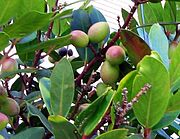Persea indica
| Persea indica | |
|---|---|

| |
| Scientific classification | |
| Kingdom: | Plantae |
| Clade: | Tracheophytes |
| Clade: | Angiosperms |
| Clade: | Magnoliids |
| Order: | Laurales |
| Family: | Lauraceae |
| Genus: | Persea |
| Species: | P. indica
|
| Binomial name | |
| Persea indica (L.) Spreng.
| |
Persea indica is a species of plant in the family Lauraceae. It belongs to the evergreen tree genus Persea of about 150 species, of which the avocado, P. americana, is the best known.
It is native to Madeira and the Canary Islands and introduced in the Azores in Macaronesia.[1] It is threatened by habitat loss. It is the vegetable symbol of the island of La Gomera.[2]
Overview[]
This article needs additional citations for verification. (August 2015) |
The family Lauraceae was part of Gondwanaland flora. There they spread over most of the continent. The genus Persea died out in increasingly xerophytic Africa, starting with the freezing of Antarctica about 20 million years ago and the formation of the Benguela current. The genus is extinct in Africa, save for P. indica, which survives in the fog shrouded mountains of the Canary Islands, which with Madagascar, constitute Africa's Laurel forest plant refugia.
Fossil evidence indicates that the genus originated in West Africa during the Paleocene, and spread to Asia, to South America, and to Europe and thence to North America. It is thought that the gradual drying of Africa, west Asia, and the Mediterranean from the Oligocene to the Pleistocene, and the glaciation of Europe during the Pleistocene, caused the extinction of the genus across these regions, resulting in the present distribution.
Persea indica is a species exclusive to Laurisilva, since this habitat is constantly threatened by encroaching agriculture, the laurel forest animal or vegetal species had already become rare in many of its former habitats and are threatened by habitat loss.

Fruits

Seeds

Shoot
Fossil record[]
Fossils of Persea indica have been described from the fossil flora of Kızılcahamam district in Turkey, which is of early Pliocene age.[3]
See also[]
References[]
- ^ a b Fernandes, F.; da Silva Menezes de Sequeira, M.P. (2017). "Persea indica". IUCN Red List of Threatened Species. 2017: e.T30329A102153566. doi:10.2305/IUCN.UK.2017-3.RLTS.T30329A102153566.en. Retrieved 15 November 2021.
- ^ "Símbolos de la naturaleza para las Islas Canarias" [Natural Symbols for the Canary Islands]. Ley No. 7/1991 of 30 April 1991 (in Spanish). Vol. 151. pp. 20946–20497 – via BOE.
- ^ Kasaplıgil, Baki (1977). "Ankara, Kızılcahamam yakınındaki Güvem köyü civarında bulunan son tersiyer kozalaklı-yeşil yapraklı ormanı" [A Late-Tertiary Conifer-Hardwood Forest From the Vicinity of Güvem Village, Near Kızılcahamam, Ankara] (PDF). Bulletin of the Mineral Research and Exploration (in Turkish and English). Ankara: General Directorate of Mineral Research and Exploration. 88: 94-102.
- IUCN Red List least concern species
- Persea
- Flora of Madeira
- Flora of the Canary Islands
- Flora of Macaronesia
- Trees of Mediterranean climate
- Conservation dependent plants



